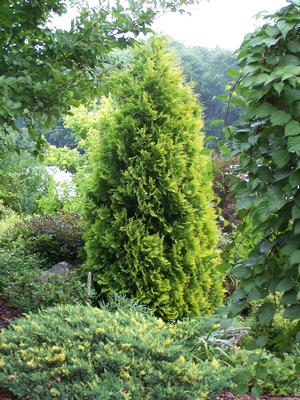
1. Example of a spreading form, Juniperus procumbens 'Variegata' (foreground) and a pyramidal form, Thuja occidentalis 'Lutea' (backdrop)
Design Part II: Design Tools - The Building Blocks
Gardeners struggle with design. It goes with the territory, so to speak. In this, the first in a 3-part series focused upon garden design, we will examine the Tools of Design. In the second article we will focus on the Principles of Design. In the final episode we will review how we might apply these aspects to our landscapes. For my readers who are interested in better understanding design theory I strongly recommend that you clip all 3 articles for they can advance your personal approach to the aesthetics of gardening.
The Tools of Design define characteristics of plants which are building blocks in the garden. The first two Tools of Design are form and line. A plant’s shape is its form. The outline of form is its line. Form and line are inextricably linked design elements. The following are categories of form…
Globose forms are rounded (see pic 3). Spreading (see pic 1) forms display a horizontal branching habit. Spreading and rounded outlines strung together in a garden will gently carry the eye along and across a landscape. For example, a rounded or spreading species woven together in a straight or even snaky row acts as a single element, its line directing the eye to its end. Place rounded or spreading forms along a path, trim into a formal hedge and the visual power the line creates will pull your eye up the row until the element either ends or disappears in the distance, rather like the perspective in Renaissance art.
Fastigiate, columnar forms are the exclamation points, tall and narrow they point skyward (see pics 2 and 3). Columnar or upright forms demand the eye’s notice. A single columnar shrub may be very effective marking the entrance of a path. The classic device to draw the eye at front door is to plant a pair, one on each side of the home’s entrance. Three may be used in an asymmetric configuration as components of a larger transition from one garden room to the next. In this application rather than a dull, forgettable connector through which one may pass through quickly, a dynamic and exciting moment may created which may lead into a calm, peaceful setting beyond. Columnar elements generally should be used judiciously as accents. But, of course, it depends upon personal taste and the effect you may wish to create in a section of the landscape.
Pyramidal or conical shapes are the outline of the typical Christmas tree (see pics 1 and 3). They are the kinder, gentler upright form: certainly more dynamic than rounded and spreading forms but not quite the exclamation points that are a magnet to the eye.
Whereas columnar forms may lead the eye towards the sky cascading forms with their weeping branches carry the eye down towards the ground. They can create important contrast to other shapes in the garden and draw a line that leads nicely to a sitting area, for instance, perhaps at the end of a flourish of plants that would lead into an open area such as a lawn or a patio.
The third basic design element is texture. Are the leaves tiny, large or bold (see pic 4)? Are they polished, lacquer-like, or are they matte finished? Are they smooth or rugose (coarse, crinkled), heavily veined or not? Are they tomentose (fuzzy) or sport a waxy glaucous blush? All of these characteristics contribute to the overall texture of a plant. Plants with glossy and bold foliage draw the eye whereas plants with minute foliage and matte finishes recede into the background. Shrubs with sparse foliage are less of a draw than those densely foliated.
Color is the fourth and final basic design element. You will create a beacon by including a single gold specimen among green neighbors. A quieter but similar situation can be had by including a blue grouping among the green. In either context color will be a visual siren call. Gray colors en masse recede. Greens are soothing and cooling especially in hot weather. Variegated plants also draw the eye, hot colors moreso. Caution: color is the single element that is probably overused by gardeners. Compared to form and line, color is often the weakest element. For instance, though we may have plotted color effectively if there are not also distinguishing sizes and forms creating dynamic contrast then we will have invented a dull landscape. Onlookers will be left with a feeling that something is missing; that this garden is not only boring but literally flat.
These Tools of Design define the building blocks in your landscape: the plants. The myriad possibilities are virtually endless, for there are annuals, biennials, perennials, shrubs, vines and trees. Consider the vast number of varieties and cultivars, often within a single species an endless stream of possibility emerges. In the second part of this series we will look at the Principles of Design. Stay tuned.
Penned by Wayne Paquette, Winter 2008

